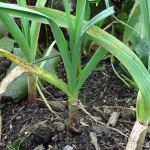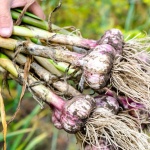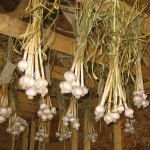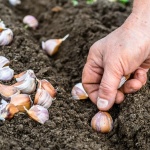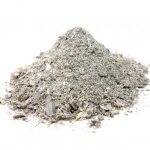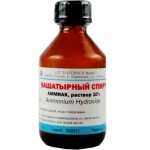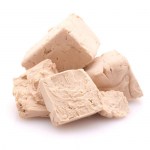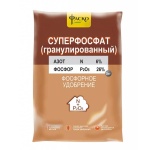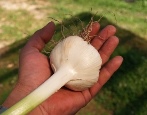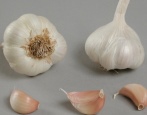
- Sheet length, cm: 50
- Sheet width, cm: 3-4
- Leaf color: green with a waxy bloom
- The form: rounded flat
- Bulb size: large
- Bulb weight, g: 100-120
- Number of teeth: 4-7
- Clove weight, g: 20
- Dry scales: white or with a pink tint, with a characteristic pattern of lilac veins
- Color of the pulp: creamy white
Lyubasha is the most popular podzimny type of garlic, which has remarkable medicinal properties and is distinguished by the excellent chemical composition of the bulbs. In addition, the culture is extremely unpretentious in care, resistant to typical diseases and pest attacks. It is also characterized by reliable frost resistance, heat resistance and the ability to long-term storage.
Breeding history
Culture was the fruit of the works of the Ukrainian specialist I. Zakharenko. The author honorably named it in honor of the mother-in-law. After successful tests, the culture was regionalized in Ukraine, Russia, Belarus and Moldova. Since Lyubasha is unpretentious to climatic conditions, it quickly spread over the territories of most regions of the country. This was also due to the significant immune potential of the plant against most fungal diseases typical for the culture, as well as unpretentiousness in care, winter hardiness and heat resistance. Lyubasha also has a consistently high yield.
Description of the variety
Winter culture, mid-ripening, shooting, frost-resistant, with a powerful root system.
Its main difference from similar winter plants is the long storage time of the crop. It differs both in fruits of significant size and their special taste properties.
It is characterized by a significant content of vitamin C, proteins, amino acids, essential oils, selenium and other trace elements.
The medicinal and bactericidal properties of the culture are exceptional:
it successfully resists pathogenic viruses, bacteria, microbes and fungi;
is able to accelerate the processes of restoration of damaged tissues;
stimulates an increase in the strength of heart contractions;
blocks the formation of excess cholesterol;
prevents the progression of atherosclerosis;
reduces the degree of blood clots;
blocks vascular spasms;
lowers blood pressure;
reduces the degree of inflammation of the mucous tissues in the airways in case of bronchopulmonary diseases.
In case of oncological diseases, in terms of its effect, Lyubasha is equated to chemotherapy, activating the functioning of immune cells.
Additionally culture:
stimulates the production of digestive enzymes;
is a choleretic raw material for the production of allochol;
intensifies the functioning of the gonads and disinfects the genitourinary system;
prevents the onset of senile dementia, contributing to productive longevity;
is an effective means of combating vitamin deficiency and scurvy.
Characteristics of the appearance of plants and bulbs
The culture reaches a height of 100-120 cm. The leaves of the plant are elongated, densely arranged, erect, dark emerald color with a small waxy coating, slightly stiff, 50 cm long, 3-4 cm in width.
The head is of a rounded-flat configuration, large, weighing 100-120 cm. The number of cloves is 4-7, each of them weighing 20 g. The color of dry scales is white with a pinkish tinge, characteristic veins are distinctly expressed. The color of the flesh is creamy white.
In terms of chemical composition, the bulb includes: dry matter - 43%, ascorbic acid - 34 mg%, amino acids and proteins - 8% of the fresh mass, trace elements - 1%, selenium - 170 mg / kg, essential oils - about 0.4%, sulfur-nitrogen substances (allicin) - 0.3%.
The head storage level is high - up to 10 months.
Purpose and taste
The fruits are used for canning, for almost all types of processing. White teeth, crispy. The taste of the cloves is spicy, with a pronounced characteristic garlic aroma. Green shoots are added to salads - they have a softer taste.
Maturation
The culture is mid-season. The time from germination to yellowing of leaves is about 98 days.
Yield
The yield is high, on average 1.5-2 kg / sq. m.
Landing dates
The timing of planting garlic begins at the end of October and lasts until mid-November (20-40 days before the first frost). In the spring, they are planted in moist soil, after the snow melts, but no later than the 2nd decade of April.
Planting is preceded by feeding 12 liters of humus and a liter of wood ash per 1 m2. Disinfection is carried out previously (2 days before disembarkation) with a non-concentrated saline solution.
During the landing, they are guided by a soil temperature of + 10 ... 15 degrees Celsius. Podwinny garlic develops intensively at +2 degrees, and at lower temperatures it does not have time to adapt. The optimal temperature regime for the development of spring crops is + 16 ... 20 degrees.
Growing and care
The standard planting pattern is 6-8 cm between plants, 15-20 cm between rows. Care is standard.
The first irrigation is carried out at the end of April (morning or evening). Irrigation is stopped two weeks before the harvest. On hot days, we recommend irrigating the crop weekly. Watering is not carried out in autumn. Abundant irrigation is practiced until the 2nd decade of June. Untimely irrigation of a winter variety (during dry summers) is fraught with the death of the crop. Irrigation water consumption depends on the quality of the soil and planting sites. Excessive irrigation, like drying out the soil, negatively affects crop growth.
Top dressing is made using chicken manure, rotted cow or horse manure. Potassium and phosphorus supplements are carried out every 10 days. In the spring, fertilizing with nitrogenous compounds (in liquid form) is carried out. Chernozem is added twice - in April and June. The third supplement is made two weeks before the planned collection.
Of other measures for the care of Lyubasha, we indicate:
when arrows appear, they are pinched at a height of more than 10 cm;
for the winter period, the culture is moderately (34 cm) mulched with peat or straw;
after the snow melts, mulch should be removed;
weeding should be regular;
14 days after the emergence of sprouts, the soil must be loosened.
Bulbs usually ripen by the second decade of July, and their readiness is determined by the yellowish tips of the leaves. The harvest should be dug in dry weather. The heads are removed, cleaned from the ground, and then put into the shade and dried.
When collecting the fruits, the heads must be removed from the soil with a shovel (we do not recommend pulling them out using the stems).
It should be remembered that the crop freezes when there is a shortage of snow, and therefore mulching is necessary.
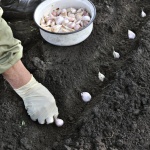
You can plant garlic twice a year. The spring species is best planted in the spring, the winter one is sown before winter. Planting time depends on the region, climatic conditions, varieties, favorable days. It is also necessary to properly prepare the planting material and beds.
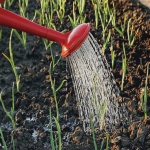
Soil requirements
The culture develops productively on neutral, loose, well-aerated soils. It is better to plant it every year in new places, (areas without ground moisture are desirable) after melons and legumes, cabbage or greens.
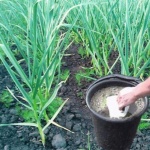
Top dressing of garlic plays a vital role in growing. The use of fertilizers contributes to the rapid growth of heads, an improvement in taste, and an increase in yield. There are many ways to feed him: this can be done with mineral or organic substances, as well as with all kinds of folk remedies.
Disease and pest resistance
The culture is characterized by a high immune potential to diseases (fusarium, fungi, etc.), to pest attacks. However, weakened plants can be attacked by pathogenic microorganisms (downy mildew, neck rot, black mold).
Pest infestations are also possible - onion flies, stem nematodes, onion hoverflies, hidden proboscis, root mites and others. During the growing season, it is sometimes observed:
slow development of feathers, which indicates a nutritional deficiency (fed with a composition of one tablespoon of urea and one glass of bird guano per 10 liters of water);
the appearance of gray-white feathers - moisture deficiency;
the appearance of pale green shades - excess moisture;
feathers stop growing and turn yellow - nutritional deficiency, excess or deficiency of moisture, the influence of pests or disease.
Preventive procedures are performed in a standard way.
